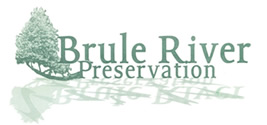Dear Brule River Roundtable Attendees, In the months since the Brule River Roundtable (BRRT), the core team has analyzed the session’s collective concerns and began evaluating solutions and actions to impact these concerns.
The top concerns were grouped in 2 categories:
In-stream /near shore habitat threats/concerns
• Lack of evaluation and monitoring of management and habitat improvements
• Connectivity /Changes in siltation and fluvial geomorphology
• Invasive species and stewardship management
• Upland portion of the watershed threats/concerns
• Sedimentation from (Nebagamon Creek), Nebagamon, South Shore Grade
• Increasing human use and population pressure
• Increased pressure to relax regulations.
Several other concerns are right behind those listed above. Many are a result of, or are associated with the top concerns.
Below please find brief up-dates on activities since the August 12, Roundtable.
I. Nebagamon South Shore Grade
Description: A 30-40 foot-tall abandoned earthen railroad grade and its companion culvert constitute a serious threat to downstream portions of Nebagamon Creek, Blueberry Creek, and the Brule River. The impacts include fish passage reduction, siltation of spawning areas and destructive impacts on the present channel function of the Brule and tributaries. . In addition to the fishery threats, the potential for harm to downstream property, and possibly human life are present. Excessive culvert blockage could cause a catastrophic failure and release up to 30,000 cubic yards of sediment into the tributaries and the Brule River.
Solution: This project has been a major priority since 2009 and a source of concern for decades. The culvert would be removed, and the railroad grade excavated to allow the return of a natural channel. Removal of a portion of the abandoned railroad grade and the culvert will eliminate the source of the sediment and the potential storage of sediment up stream of the grade.
The project design is intended to remove the present eminent threat to the fishery and hydrology.
Funding: The project will enable multiple benefits for a relatively modest investment. A pre-formal bid cost estimate is as follows:
1. Design $5,000
2. Labor (tree, culvert, concrete removal, earth excavation)$45,000
3. Labor (earth hauling) $30,000
4. Heavy equipment rental $35,000
5. Site Supplies (erosion controls, construction fencing, boulders for stream grade control, seeding, tree planting, etc.) $5,000
6. Contingencies $10,000
________________________________________________________________________
Total $130,000
Brule River Coalition and WDNR funding progress to date:
Pledges from Agency and Conservation Organizations $59,000
Grant submitted to USFWS $38,000
Misc. additional NGO grants in process $5,000
___________________________________________________________
Total confirmed and pending $102,000
Efforts are in process to secure the balance. The project team is very encouraged to believe that based on results to date, success is very likely, and soon! Funding strategies continue in a variety of outreach efforts.
If you would like to contribute, call or contact Dave Zentner 218-724-3926 or dzentner@charter.net.
The present plan is to bid the project in early 2018 and complete the project between May
15th and September 15th, 2018
II. Invasive Species
Exotic invaders continue to be a major concern voiced by BRRT attendees. Most of the concerns focused on aquatic exotics. However, there are also concerns about the watershed impacts of terrestrial invaders. Over the winter of 2017-18, the Brule River Coalition representatives intend to discuss strategies that may help reduce, and or, slow down the spread of these invaders. See Wisconsin First Detector Network (WIFDN) for a monitoring scheme. (https://fyi.uwex.edu/wifdn/)
III. Connectivity
A lot of discussion about the importance of “connectivity” for the Brule River fishery was a third take-away from the BRRT. This is in the form of fish passage, culvert impact on hydrology of the river, and land use and restoration, particularly in the headwaters. Discussions of culvert inventories, working with county and town road crews, and “slow the flow” initiatives are being discussed. We have local examples in the Superior Basin of how to conduct such inventories. These can be hired and/or volunteers with training. On September 27th, a meeting was held to discuss how private and public land management could be carried out across property lines to restore the hydrology, wildlife and vegetation of the barrens at the headwaters of the Brule. Implementation of such a demonstration project is on the radar. This can include timber management, controlled burns, and coordinated tree planting across property lines.
IV. Miscellaneous:
We have an inventory of related issues. Some, such as water temperature monitoring, habitat projects, user education, rare plant and animal community inventories are examples of issues that may be in the “parking lot” for now, but not forgotten. Your interest in and related suggestions are very welcome.
Our best wishes to all for 2018. Working together we all are better!
Sincerely,
Brule River Coalition
